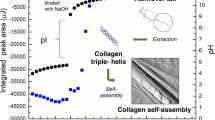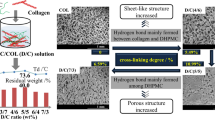Abstract
The effect of N-hydroxysuccinimide activated adipic acid (NHS-AA) on the properties of alkali-solubilized collagen solutions was examined. The residual amino group content in crosslinked collagen, determined by trinitrobenzensulfonic acid (TNBS) assay, was decreased with increasing NHS-AA concentration. The results from differential scanning calorimeter (DSC) indicated that the maximum denaturation temperature (T d) of crosslinked collagen solution was about 4.2°C higher than that of un-crosslinked collagen solution (36.6°C). Moreover, the values of storage modulus (G′), loss modulus (G″) and complex viscosity (η*), obtained by means of dynamic frequency sweeps, were increased as NHS-AA concentration added up to 1.5 mM, and then decreased slightly when further increased NHS-AA concentration. Besides, for collagen solution crosslinked with 1.5 mM NHS-AA, dynamic denaturation temperature (T dd) was about 1.1°C lower than T d (40.8°C), and the Arrhenius-type time-temperature superposition (TTS) principle was applied to yield the activation energy to be 474.4 kJmol−1.
Similar content being viewed by others
References
Achet, D. and X.W. He, 1995, Determination of the renaturation level in gelatin films, Polymer 36, 787–791.
Anderson G. W., J. E. Zimmerman, and F.M. Callahan, 1964, The use of esters of N-Hydroxysuccinimide in peptide synthesis, J. Am. Chem. Soc. 86, 1839–1842.
Aoki, H., T. Taguchi, H. Saito, H. Kobayashi, K. Kataoka, and J. Tanaka, 2004, Rheological evaluation of gelatin gels prepared with a citric acid derivativeas a novel cross-linker, Mater. Sci. Eng., C. 24, 787–790.
Bigi, A., G. Cojazzi, S. Panzavolta, K. Rubini, and N. Roveri, 2001, Mechanical and thermal properties of gelatin films at different degrees of glutaraldehyde crosslinking, Biomaterials 22, 763–768.
Bigi, A., S. Panzavolta, and K. Rubini, 2004, Relationship between triple-helix content and mechanical properties of gelatin films, Biomaterials 25, 5675–5680.
Chen, R.N., H. O. Ho, and M. T. Sheu, 2005, Characterization of collagen matrices crosslinked using microbial transglutaminase, Biomaterials 26, 4229–4235.
Chin, N.L., S.M. Chan, Y.A. Yusof, T.G. Chuah, and R.A. Talib, 2009, Modelling of rheological behaviour of pummelo juice concentrates using master-curve, J. Food Eng. 93, 134–140.
Dupont Gillain C.C, I. Jacquemart, and P.G. Rouxhet, 2001, Influence of the aggregation state in solution on the supramolecular organization of adsorbed type I collagen layers, Colloids and Surfaces B: Biointerfaces 43, 179–186.
Friess, W. and M. Schlapp, 2001, Effects of processing conditions on the rheological behavior of collagen dispersions, Eur.J. Pharm. Biopharm. 51, 259–265.
Friess, W., 1998, Collagen-biomaterial for drug delivery, Eur. J. Pharm. Biopharm. 45, 113–136.
Goissis G, E.M. Junior, R.A.C. Marcantönio, R.C.C. Lia, D. C.J. Cancian, and W. M. Carvalho, 1999, Biocompatibility studies of anionic collagen membranes with different degree of glutaraldehyde cross-linking, Biomaterials 20, 27–34.
Heymans, N., 2003, Constitutive equations for polymer viscoelasticity derived from hierarchical models in cases of failure of time-temperature superposition, Signal Processing 83, 2345–2357.
Iwata, H., S. Matsuda, K. Mitsuhashi, E. Itoh, and Y. Ikada, 1998, A novel surgical glue composed of gelatin and N-hydroxysuccinimide activated poly (L-glutamic acid): Part 1. Synthesis of activated poly (L-glutamic acid) and its gelation with gelatin, Biomaterials 19, 1869–1876.
Kasapis, S. and J. R. Mitchell, 2001, Definition of the rheological glass transition temperature in association with the concept of iso-free-volume, Int. J. Biol. Macromol. 29, 315–321.
Khor, E., 1997, Methods for the treatment of collagenous tissues for bioprostheses, Biomaterials 18, 95–103.
Korhonen, M., L. Hellen, J. Hirvonen, and J. Yliruusi, 2001, Rheological properties of creams with four different surfactant combinations-effect of storage time and conditions, Int. J. Pharm. 221, 187–196.
Kuijpers, A. J., G. H. M. Engbers, J. Feijen, S. C. D. Smedt, T. K. L. Meyvis, J. Demeester, J. Krijgsveld, S. A. J. Zaat, and J. Dankert, 1999, Characterization of the network structure of carbodiimide cross-linked gelatin gels, Macromolecules 32 3325–3333.
Lai, G.L., Z.L. Du, and G.Y. Li, 2007, The rheological behavior of collagen dispersion/poly (vinyl alcohol) blends, Korea Aust Rheol. J. 19, 81–88.
Lai, G.L., Y. Li, and G.Y. Li, 2008, Effect of concentration and temperature on the rheological behavior of collagen solution, Int. J. Biol. Macromol. 42, 285–291.
Li, R.Z., 2000, Time-temperature superposition method for glass transition temperature of plastic materials, Mater. Sci. Eng, A. 278, 36–45.
Li, Y., Y.W. Li, Z.L. Du, and G.Y. Li, 2008, Comparison of dynamic denaturation temperature of collagen with its static denaturation temperature and the configuration characteristics in collagen denaturation processes, Thermochimica Acta. 469, 71–76.
Ma, L., C.Y. Gao, Z.W. Mao, J. Zhou, and J.C. Shen, 2004, Enhanced biological stability of collagen porous scaffolds by using amino acids as novel cross-linking bridges, Biomaterials 25, 2997–3004.
Olde Damink, L.H.H., P.J. Dijkstra, M.J.A. van Luyn, P.B. van Wachem, P. Nieuwenhuis, and J. Feijen, 1996, Cross-linking of dermal sheep collagen using a water-soluble carbodiimide, Biomaterials 17, 765–773.
Saito, H., T. Taguchi, H. Kobayashi, K. Kataoka, J. Tanaka, S. Murabayashi, and Y. Mitamura, 2004, Physicochemical properties of gelatin gels prepared using citric acid derivative, Mater. Sci. Eng., C. 24, 781–785.
Sheu, M. T., J. C. Huang, G. C. Yeh, and H.O. Ho, 2001, Characterization of collagen gel solutions and collagen matrices for cell culture, Biomaterials 22, 1713–1719.
Taguchi, T., H. Saito, Y. Uchida, M. Sakane, H. Kobayashi, K., Kataokaa, and J. Tanaka, 2004, Bonding of soft tissues using a novel tissue adhesive consisting of a citric acid derivative and collagen, Mater. Sci. Eng., C. 24, 775–780.
Taguchi, T., H. Saito, H. Aoki, Y. Uchida, M. Sakane, H. Kobayashi, and J. Tanaka, 2006, Biocompatible high-strength glue consisting of citric acid derivative and collagen, Mater. Sci. Eng., C. 26, 9–13.
Usha, R. and T. Ramasami, 2004, The effects of urea and n-propanol on collagen denaturation: using DSC, circular dicroism and viscosity, Therochimica Acta 409, 201–206.
Vaidyanathan, T.K., J. Vaidyanathan, and Z. Cherian, 2003, Extended creep behavior of dental composites using time temperature superposition principle, Dental Materials 19, 46–53.
Zeeman, R., P. J. Dijkstra, P.B. van Wachem, M. J.A. van Luyn, M. Hendriks, P.T. Cahalan, and J. Feijen, 1999, Successive epoxy and carbodiimide cross-linking of dermal sheep collagen, Biomaterials 20, 921–931.
Zhang, Z.K., G.Y. Li, and B. Shi, 2006, Physicochemical properties of collagen, gelatin and collagen hydrolysate derived from bovine limed split wastes, J. Soc. Leather Technol. Chem. 90, 23–28.
Zhao, S., M. Zhang, G.Y, Li, and W.T. Liu, 2009, Preparation and characterization of alkali-soluble collagen from pigskin shavings, J. Amer. Leather Chem. Ass. 104, 344–351.
Author information
Authors and Affiliations
Corresponding author
Rights and permissions
About this article
Cite this article
Chen, Y., Zhang, M., Liu, W. et al. Properties of alkali-solubilized collagen solution crosslinked by N-hydroxysuccinimide activated adipic acid. Korea-Aust. Rheol. J. 23, 41–48 (2011). https://doi.org/10.1007/s13367-011-0006-6
Received:
Revised:
Accepted:
Published:
Issue Date:
DOI: https://doi.org/10.1007/s13367-011-0006-6




